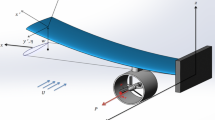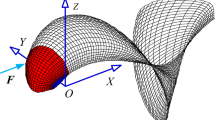Abstract
The unsteady bearing forces of a propeller can be significantly affected by external transverse excitations. This paper numerically studies the unsteady variation characteristics of the bearing forces of a three-blade conventional propeller with external transverse excitations or without excitations. The dynamic mesh method combined with the RANS turbulence model is employed. The numerical simulation shows the frequency response in the frequency domain of KT, KQ under external transverse excitations. The frequency of the response is found always equal to twice of the excitation frequency. If the amplitude of the external transverse excitation keeps constant, the amplitude of the response increases with the increase of the excitation frequency. If the excitation frequency keeps constant, the amplitude of the response increases with the increase of the excitation amplitude, in a power-law relationship. The pressure distribution can be significantly affected by the external transverse excitation, leading to a high irregularity of the flow field.
Similar content being viewed by others
References
Wei Y., Wang Y. Unsteady hydrodynamics of blade forces and acoustic responses of a model scaled submarine excited by propeller’s thrust and side-forces [J]. Journal of Sound and Vibration, 2013, 332(8): 2038–2056.
Zhou C. Vibration research on ship shafting system [D]. Doctoral Thesis, Harbin, China, Harbin Engineering University, 2006(in Chinese).
Zheng J., Meng F., Li Y. Design and experimental testing of a free-running ship motion control platform [J]. IEEE Access, 2018, 6: 4690–4696.
Fuad N., Chowdhury M. K., Yasin M. S. et al. Development of a novel device for harnessing wasted energy behind a marine propeller [J]. Procedia Engineering, 2017, 194: 378–385.
Wang G. Q., Zhang J. H. A design method of ducted propeller by coupled lifting surface theory/panel method [J]. Journal of Ship Mechanics, 2003, 7(4): 21–27(in Chinese).
Ma C., Qian Z. F., Chen K. Using vortex lattice and surface panel method to predict the unsteady hydrodynamic performance of podded propulsors [J]. Journal of Ship Mechanics, 2014, 18(9): 1035–1043(in Chinese).
Zhang H., Cui H. Predicting hydrodynamic performance of ducted propeller using surface panel method [J]. Mine Warfare and Ship Self-defence, 2013, 21(3): 33–37.
Koushan K., Krasilnikov V. Experimental and numerical investigation of open thrusters in oblique flow conditions [C]. Proceeding of 27th Symposium on Naval Hydrodynamics, Seoul, Korea, 2008.
Zhang Z. R., Hong F. W. The study of numerical analysis method on the performance of propeller under oblique flow [C]. Proceeding of the Ship Mechanics Congress, Chengdu, China, 2007(in Chinese).
Hu X. F., Huang Z. Y., Hong F. W. Unsteady hydrodynamics forces of propeller predicted with viscous CFD [J]. Chinese Journal of Hydrodynamics, 2009, 24(6): 734–739(in Chinese).
Guo C. Y., Ma N., Yang C. J. Numerical simulation of a podded propulsor in viscous flow [J]. Journal of Hydrodynamics, 2009, 21(1): 71–76.
Lesfvendahl M., Troeng C. Computation of cycle-to-cycle variation in blade load for a submarine propeller using LES [C]. Proceedings of Second International Symposium on Marine Propulsors, Hamburg, Germany, 2011.
Zhu P., Bi Y., Ye J. Comparison analysis of three kinds of computational methods for the bearing force of propellers [J]. Chinese Journal of Ship Research, 2015, 10(1): 83–87(in Chinese).
Zhang K. Q., Ye J. M., Yu A. B. Numerical simulation of propeller unsteady hydrodynamics in non-uniform flow [J]. Ship Science and Technology, 2018, 40(2): 33–38.
Li L., Wang C., Sun S. Numerical prediction analysis of propeller exciting force for hull-propeller-rudder system [J]. Journal of Wuhan University of Technology (Transportation Science and Engineering), 2015, 39(4): 768–772, 777.
Huang M. M., Wu C. S. Effect of heaving on propeller performance in open water [J]. Chinese Journal of Hydrodynamics, 2015, 30(3): 284–290(in Chinese).
Sharma A. Numerical modeling of a hydrofoil or a marine propeller undergoing unsteady motion via a panel method and rans [D]. Doctoral Thesis, Austin, USA, The University of Texas at Austin, 2011.
Sharma A., He L., Spyros A. K. Numerical modeling of a hydrofoil or a marine propeller undergoing unsteady motion [C]. Second International Symposium on Marine Propulsors smp’11, Hamburg, Germany, 2011.
Spyros A. K., Ye T., Abhinav S. Numerical modeling of a marine propeller undergoing surge and heave motion [J]. International Journal of Rotating Machinery, 2012, 2012: Article ID 257461.
ANSYS FLUENT. Theory guide [M]. ANSYS Inc., 2011.
Domont K., Stijnen J. M. A., Vierendeels J. et al. Validation of a fluid-structure interaction model of heart valve using the dynamic mesh method in fluent [J]. Computer Methods in Biomechanics and Biomedical Engineering, 2004, 7(3): 139–146.
Gao F. D., Pan C. Y., Han Y. Y. Numerical computation and analysis of unsteady viscous flow around autonomous underwater vehicle with propellers based on sliding mesh [J]. Journal of Central South University, 2012, 19: 944–952.
Ji B., Luo X., Wu Y. Unsteady cavitation characteristics and alleviation of pressure fluctuations around marine propellers with different skew angles [J]. Journal of Mechanical Science and Technology, 2014, 28(4): 1339–1348.
Jessup S. D. Measurement of multiple blade rate unsteady propeller force [R]. David Taylor Research Center, 1990.
Boswell R. J., Miller M. L. Unsteady propeller loading-measurement, correlation with theory,and parametric study [R]. Washington, USA: Naval Ship Research and Development Center, 1968.
Author information
Authors and Affiliations
Corresponding author
Additional information
Project supported by the China Postdoctoral Science Foundation (Grant No. 2017M621455).
Biography: Min-hua Shu (1984-), Male, Ph. D. Candidate
Rights and permissions
About this article
Cite this article
Shu, Mh., Chen, K., You, Yx. et al. Numerical study on variation characteristics of the unsteady bearing forces of a propeller with an external transverse excitation. J Hydrodyn 31, 400–412 (2019). https://doi.org/10.1007/s42241-018-0107-5
Received:
Revised:
Accepted:
Published:
Issue Date:
DOI: https://doi.org/10.1007/s42241-018-0107-5




